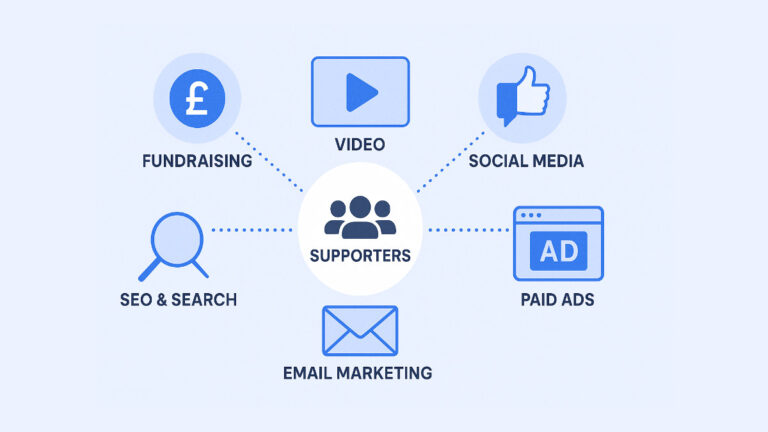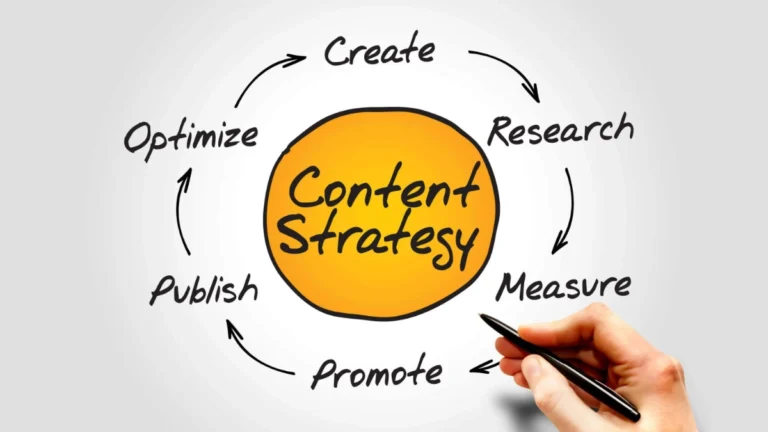Charities in the UK are navigating a changing sector. More people are discovering causes, making donations, and engaging with campaigns online, and this shift isn’t temporary. It’s become a core part of how supporters connect with the issues they care about.
Online giving has grown significantly in recent years, specifically since the pandemic. Research shows that more than half (56%) of donors under 40 prefer to give through digital channels. For younger generations, online platforms aren’t just convenient, they’re the default. If your charity isn’t reaching people online, you’re missing out on a major segment of potential supporters.
With thousands of charities competing for attention, digital marketing offers a way to stand out. A thoughtful digital strategy, whether it’s a targeted social media campaign or a well-timed email, can help even the smallest organisations punch above their weight and get noticed by the right people.
Digital marketing isn’t just about raising money. It also helps charities recruit volunteers, share stories, promote events, and raise awareness. It can strengthen relationships with existing supporters and open doors to entirely new audiences when used well.
In this guide, I’ll walk through the key areas of digital marketing that matter most for UK charities and how to approach them in a way that’s practical, focused and effective.
Essential SEO Strategies for UK Charities
Search Engine Optimisation (SEO) might sound technical, but at its core, it’s about helping people find your charity online when they search for help, want to donate, or look to get involved. For UK charities, smart SEO can make the difference between being invisible and being the organisation someone reaches out to.
Whether you’re a food bank in Manchester or a mental health charity in Bristol, these strategies will help you reach more people where they’re already looking online.
1. Keyword Research & Content Planning
Before writing blog articles or updating your website, you need to understand what your audience is searching for.
- Think local and specific: Instead of broad keywords like “donate to charity,” focus on long-tail phrases such as “homeless shelter donations London” or “volunteer Manchester food bank.” These are more likely to connect you with people ready to take action.
- Use the right tools: Free and affordable tools like Google Keyword Planner, SEMrush, and AnswerThePublic can show you exactly what people are typing into search engines.
- Build content clusters: Organise your content around key themes, for example, if you support vulnerable families, group your content into topics like “crisis support,” “family fundraising ideas,” or “ways to help single parents.” This makes it easier for Google (and your visitors) to navigate your site.
2. On-Page Optimisation
Small tweaks to your website’s pages can have a big impact on how you appear in search results.
- Craft effective titles and descriptions: Swap out vague titles like “Donate Here” for specific ones such as “Donate to End Child Poverty | UK Charity.” This tells search engines and users exactly what your page is about.
- Optimise your images: Always add alt-text to images for accessibility and SEO. A good example: “Volunteers packing meals at Birmingham food bank.”
- Link internally: If a blog article talks about helping rough sleepers, link it to your volunteer sign-up or donation page. This guides users and helps Google understand how your pages connect.
3. Local SEO for Community Impact
Most UK charities serve a specific area, and that should be reflected in your SEO.
- Optimise your Google Business Profile: Include accurate service areas, event details, and authentic reviews or testimonials from beneficiaries and supporters.
- Build local connections: Partner with local councils, schools, mosques, churches and businesses. When they link to your site, it boosts your local search visibility.
- Use schema markup: Structured data (like schema.org) helps search engines understand your site. For charities, using a donation-specific schema can highlight your fundraising campaigns directly in search results.
4. Technical SEO Essentials
Even great content won’t rank well if your site is slow or difficult to navigate.
- Prioritise mobile users: Most visitors will be on their phones. Make sure your site loads quickly (aim for under 2 seconds) and looks good on smaller screens.
- Audit regularly: Tools like Screaming Frog help you spot broken links, duplicate content, or missing metadata.
- Create and submit an XML sitemap: This tells search engines what pages to crawl. Highlight the most important ones like your donation page, contact form, or volunteer sign-up.
Charity Content Marketing That Inspires Action
Great stories move people to action, and in the charitable sector, your most powerful marketing tool isn’t flashy ads; it’s your actual impact. Charity content marketing is about sharing those stories in a way that builds trust, sparks emotion, and encourages people to give, volunteer, or spread the word.
If you’re trying to reach potential donors, volunteers, or local supporters, the right content can open hearts and inspire action.
1. Impact-Driven Blogging
Blogging might feel outdated, but for charities, it’s a powerful way to show your mission and appear in Google searches, especially when done with heart and strategy.
- Tell genuine stories: Use case studies like “How £50 Helped Rehouse a Family” to show the human impact behind the numbers. These stories make your cause relatable and highlight the tangible results of support, just like Cancer Research UK and other large charities do so well.
- Create evergreen value: Write useful content like “10 Ways to Support Mental Health Charities” that stays relevant all year round. This kind of content is easily shareable and positions your charity as a helpful resource, not just a fundraising ask.
- Repurpose to reach more people: Turn one blog post into a short video, an Instagram carousel, or even a podcast topic. A single story can become a month’s worth of content across different platforms and meet people where they already are.
2. Video & Visual Storytelling
When attention spans are short, video and images can quickly draw people in, especially when they show the reality of your work.
- Short-form videos: Use platforms like TikTok, Instagram Reels, or YouTube Shorts to highlight “a day in the life” of a staff member, volunteer, or even a beneficiary (with permission). These glances behind the scenes build authenticity and trust.
- Live streams: Host virtual events or tours, for example, walking viewers through your food bank, community centre, or animal shelter. It’s a great way to show transparency and invite supporters into your world, especially if they can’t visit in person.
Engaging Donors Through Social Media
Social media isn’t just a nice-to-have for charities looking to connect with today’s supporters; it’s where conversations, community, and causes come to life. Whether it’s a £5 donation, a share, or a volunteer sign-up, platforms like Instagram, Facebook, and LinkedIn give huge potential to engage people where they already spend their time.
But deep engagement goes beyond scheduled posts. Social media for UK nonprofits works best when it’s human, honest, and mission-driven.
1. Choosing the Right Platform for Your Message
Each platform has its own culture and strengths. Rather than posting the same content everywhere, customise your message to fit how your audience uses each space:
- Facebook: Tap into local community groups or start your own to support peer-to-peer fundraising. It’s also a great platform for promoting events and encouraging constant donor relationships through comments and shares.
- Instagram: Use visual storytelling to break down complex issues. Carousel posts work well to explain how donations are used, e.g., “Here’s what your £10 provides” with a photo per item. Stories and Reels can offer quick behind-the-scenes peeks into your day-to-day impact.
- LinkedIn: A powerful space for building credibility and attracting corporate support. Share partnership announcements, staff highlights, and thought leadership pieces that show your competence and long-term vision.
- YouTube: Use longer-form videos to tell deeper stories, from project documentaries to interviews with staff, volunteers, or beneficiaries. It’s also a valuable archive for past campaigns and impact reports.
- TikTok: Ideal for short, emotionally engaging content with a creative twist. Trends and challenges can be adapted to raise awareness, think behind-the-scenes clips, myth-busting facts about your cause, or day-in-the-life videos.
2. Creative Campaign Ideas to Try
The most successful social media campaigns are built on participation and authenticity. Here are two proven ways to build momentum:
- User-generated content (UGC): Encourage your supporters to post their own photos or stories using branded hashtags, like a “#Run5Donate5” challenge. This not only spreads awareness but also builds community through shared purpose.
- Influencer collaborations: Partner with micro-influencers (especially those connected to your cause) to share genuine reasons they support your work. A short video or personal story can carry more weight than polished adverts, and reach new audiences in the process.
Email Strategies to Engage and Retain Donors
Email remains one of the most cost-effective tools for charities to build lasting donor relationships. But it’s not just about sending out newsletters, it’s about sending the right message to the right person at the right time.
1. Targeted Segmentation for Better Donor Engagement
Treating every subscriber the same is a missed opportunity. Segment your email list based on behaviour and interests, for example:
- Monthly donors can receive exclusive updates and thank-you messages.
- Event attendees might appreciate early invitations to future events or behind-the-scenes photos.
- First-time givers may need more education and encouragement to become recurring supporters.
2. Automated Workflows
Set up automated email sequences to guide supporters along their journey and keep you top of mind:
- A welcome series that introduces your mission and shows impact from the start.
- Re-engagement campaigns for donors who haven’t interacted in 6+ months.
- Event reminders and post-event follow-ups with photos, results, and gratitude.
3. Impact Updates That Build Trust
Supporters want to know whether their contribution made a difference. Regular, honest updates go a long way:
- “Thanks to your gift, 100 children received school meals last month.”
- Include visuals, quotes, or short video clips for a stronger emotional connection.
- Make it easy to take the next step, whether that’s donating again, volunteering, or sharing.
Maximising Your Charity Advertising Budget
Charities with limited marketing spend, paid advertising can seem out of reach, but with the right strategy, it becomes one of the most powerful tools for driving donations, sign-ups, and awareness. Whether tapping into free options like Google Ad Grants or running targeted social media campaigns, paid ads can amplify your message to those most likely to act.
1. Google Ad Grants
Google offers eligible UK charities up to $10,000 USD per month in free search advertising. But to make the most of it, you’ll need to follow a few best practices:
- Stay compliant: Avoid broad or low-quality keywords like “donate” or “charity.” Instead, target high-intent phrases like “sponsor a child UK” or “refugee housing donation London.”
- Optimise your landing pages: Ensure the page you’re linking to mirrors the ad’s message. If your ad says “Support Afghan Refugees in Birmingham,” your landing page should reinforce that cause and make donating or taking action frictionless.
- Track conversions: Use Google Analytics or GA4 to monitor which ads lead to donations or sign-ups, and adjust accordingly.
2. Social Media Ads
Social platforms allow hyper-targeted advertising based on location, interests, behaviours, and even donation history. Use them to meet supporters where they already spend their time:
- Retargeting: Serve ads to users who clicked on a campaign page but didn’t complete the donation. A gentle reminder with a personal touch can dramatically increase conversions.
- A/B testing: Don’t assume, test. Compare carousel vs. video ads, different headlines, or call-to-action buttons to find what resonates most with your audience.
- Custom audiences: Upload email lists (e.g., event attendees or lapsed donors) to reconnect through Facebook, Instagram, or LinkedIn ads with customised messages.
Optimising Your Website to Convert Visitors into Supporters
Your charity website is more than just a digital brochure, it’s the frontline of your fundraising efforts. For charities, every visitor is a potential donor, volunteer, or advocate. Optimising your site to convert these visitors into active supporters is essential.
1. Creating an Effective Donation Page
A streamlined, distraction-free donation page significantly increases conversion rates. Stick to a single-column layout to guide users smoothly through the process. Reduce the number of required fields, and ask only what’s necessary.
Include a recurring donation toggle by default, with a clear explanation of the long-term impact regular giving can make.
2. Trust Signals
Visitors want to feel confident that their donation is secure and going to the right place. Prominently display your Charity Commission registration number, as well as SSL security badges and payment protection logos. Adding brief testimonials or recognisable partner logos can also reassure new supporters.
3. Mobile-Friendly Design
With over half of UK donors browsing on mobile, ensure your website loads quickly and displays properly on all screen sizes. Buttons should be thumb-friendly, forms should auto-fill where possible, and calls to action must be clear and visible without scrolling.
Using Data to Drive Constant Improvement
A successful digital strategy isn’t set-it-and-forget-it; it’s refined over time through data-driven decisions. For charities, regular performance reviews ensure your efforts are aligned with what’s working and where there’s room to grow.
1. Tracking Metrics That Matter for Charity Growth
Focus on metrics that reveal how users find and interact with your site:
- Organic traffic growth: Are more people discovering you through search?
- Donation page bounce rate: Are potential donors dropping off before giving?
- Email open and click-through rates: Are your supporters engaging with your content?
2. Powerful Tools for Charity Digital Success
- Google Analytics 4 (GA4): Understand where your traffic comes from and what actions users take.
- Hotjar or Microsoft Clarity: Use heatmaps and session recordings to spot friction points or missed opportunities on key pages.
- Google Search Console: Monitor keyword performance and fix indexing issues.
3. Optimising Your Charity’s Digital Presence
Every three months, carry out a digital audit to:
- Review keyword rankings and identify content gaps.
- Evaluate backlink quality and seek out new partnership opportunities.
- Test page speed and mobile performance.
Constant improvement means better visibility, stronger engagement, and ultimately more impact.
Building a Future-Ready Strategy for Your Charity
The digital space is evolving fast, and charities that embrace innovation will stay ahead in both reach and relevance. Future-proofing isn’t about chasing every trend, but about adopting tools and platforms that align with how people give, engage, and communicate.
1. AI Integration
Artificial Intelligence is becoming more accessible and useful for the third sector:
- Chatbots can handle common supporter questions around donations, volunteering, or event info freeing up your team’s time.
- Predictive analytics can identify which donors are likely to lapse or upgrade, helping you personalise appeals more effectively.
2. Voice Search Optimisation
As more users rely on smart speakers and voice assistants:
- Customise your SEO to natural language queries like “How can I help a local food bank?” or “Best UK charities to support monthly.”
- Use FAQ pages and conversational content to increase discoverability.
3. Exploring New Platforms for Charity Growth
- WhatsApp and Messenger groups offer private, high-engagement spaces for supporters and donors.
- Keep an eye on platforms popular with younger audiences, like BeReal or Threads, and experiment carefully, based on your capacity and audience.
Staying digitally agile ensures your charity remains visible, trustworthy, and impactful, not just now, but well into the future.
My Final Thoughts
Digital marketing isn’t a luxury for charities, it’s a necessity. From SEO and content marketing to social media, email marketing, and paid advertising, each channel plays a role in helping you raise more, reach further, and build lasting relationships with supporters.
Charities that win in the digital space are the ones who treat their websites like their front door, their content like currency, and their data like a compass.
Final Tip: Audit your digital presence every six months. Look at what’s working, what’s not, and where trust signals can be strengthened. Prioritise updates that align with Google’s E-E-A-T guidelines, such as adding named authors, trustee bios, case studies, or your most recent impact report.
Having worked closely with many charities, I understand the challenges you face: tight budgets, stretched teams, and pressure to make every pound count. That’s exactly why our approach is customised and practical.
Ready to grow your impact online?
Book your free consultation today, let’s explore how we can help you attract more supporters, drive more donations, and future-proof your cause.
Stay Updated with the Latest Charity Insights
Sign up for our newsletter to receive valuable tips, updates, and exclusive offers to help your charity thrive.



